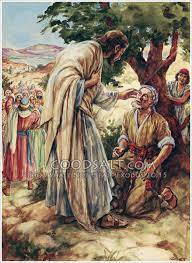Mk 7:31-37
Again Jesus left the district of Tyre
and went by way of Sidon to the Sea of Galilee,
into the district of the Decapolis.
And people brought to him a deaf man who had a speech impediment
and begged him to lay his hand on him.
He took him off by himself away from the crowd.
He put his finger into the man’s ears
and, spitting, touched his tongue;
then he looked up to heaven and groaned, and said to him,
“Ephphatha!”— that is, “Be opened!” —
And immediately the man’s ears were opened,
his speech impediment was removed,
and he spoke plainly.
He ordered them not to tell anyone.
But the more he ordered them not to,
the more they proclaimed it.
They were exceedingly astonished and they said,
“He has done all things well.
He makes the deaf hear and the mute speak.”
Bishop Barron:
Friends, in today’s Gospel, Jesus heals a deaf man who had a speech impediment.
Mark tells us that he took him “off by himself away from the crowd.” Jesus then “put his finger into the man’s ears and, spitting, touched his tongue; then he looked up to heaven and groaned, and said to him, ‘Ephphatha!’—that is, ‘Be opened!’” Looking up to his Father and inserting his fingers into the man’s ears, Jesus establishes, as it were, an electrical current, literally plugging him into the divine energy, compelling him to hear the Word.
Now, let’s look at this healing in terms of its spiritual significance. The crowd is a large part of the problem. The raucous voices of so many, the insistent bray of the advertising culture, the confusing Babel of competing spiritualities—all of it makes us deaf to God’s word. And therefore, we have to be moved to a place of silence and communion.
Jesus draws us into his space, the space of the Church. There, away from the crowd, we can immerse ourselves in the rhythm of the liturgy, listen avidly to Scripture, study the theological tradition, watch the moves of holy people, take in the beauty of sacred art and architecture. There, we can hear.


Recent Comments